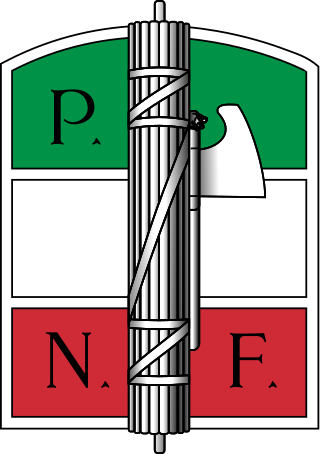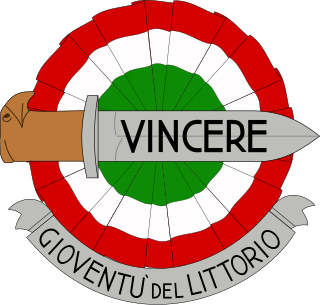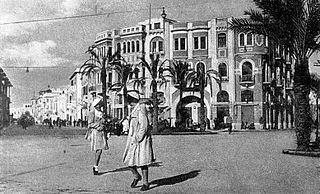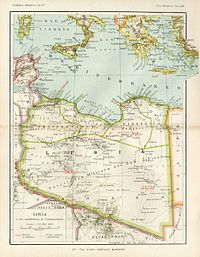Related Research Articles
Gil or GIL may refer to:

The emblem of the Italian Republic was formally adopted by the newly formed Italian Republic on 5 May 1948. Although often referred to as a coat of arms, it is an emblem as it was not designed to conform to traditional heraldic rules. The emblem is used extensively by the Italian government.

Opera Nazionale Balilla (ONB) was an Italian Fascist youth organization functioning between 1926 and 1937, when it was absorbed into the Gioventù Italiana del Littorio (GIL), a youth section of the National Fascist Party.

Italian fascism, also classical fascism and Fascism, is the original fascist ideology, which Giovanni Gentile and Benito Mussolini developed in Italy. The ideology of Italian Fascism is associated with a series of political parties led by Mussolini: the National Fascist Party (PNF), which governed the Kingdom of Italy from 1922 until 1943, and the Republican Fascist Party (PFR), which governed the Italian Social Republic from 1943 to 1945. Italian fascism also is associated with the post–war Italian Social Movement (MSI) and later Italian neo-fascist political organisations.

The Italian colonizationof Libya began in 1911 and it lasted until 1943. The country, which was previously an Ottoman possession, was occupied by Italy in 1911 after the Italo-Turkish War, which resulted in the establishment of two colonies: Italian Tripolitania and Italian Cyrenaica. In 1934, the two colonies were merged into one colony which was named the colony of Italian Libya. In 1937, this colony was divided into four provinces, and in 1939, the coastal provinces became a part of metropolitan Italy as the Fourth Shore. The colonization lasted until Libya's occupation by Allied forces in 1943, but it was not until the 1947 Paris Peace Treaty that Italy officially renounced all of its claims to Libya's territory.

The National Fascist Party was a political party in Italy, created by Benito Mussolini as the political expression of Italian fascism and as a reorganisation of the previous Italian Fasces of Combat. The party ruled the Kingdom of Italy from 1922 when Fascists took power with the March on Rome until the fall of the Fascist regime in 1943, when Mussolini was deposed by the Grand Council of Fascism. It was succeeded, in the territories under the control of the Italian Social Republic, by the Republican Fascist Party, and ultimately dissolved at the end of World War II.

A casa del Fascio, casa Littoria, or casa del Littorio was a building housing the local branch of the National Fascist Party and later the Republican Fascist Party under the regime of Italian Fascism, in Italy and its colonies, and Malta. In major urban centers, it was called the palazzo del Littorio or palazzo Littorio. Littorio means lictor, the bearer of the fasces lictorii, the symbol of Roman power adopted by the Fascist party.

Libya was a colony of Fascist Italy located in North Africa, in what is now modern Libya, between 1934 and 1943. It was formed from the unification of the colonies of Cyrenaica and Tripolitania, which had been Italian possessions since 1911.

Italian Libyans are Libyan-born citizens who are fully or partially of Italian descent, whose ancestors were Italians who emigrated to Libya during the Italian diaspora, or Italian-born people in Libya. Most of the Italians moved to Libya during the Italian colonial period.

Albanian Lictor Youth was a youth organization which served as the youth wing of the Albanian Fascist Party. The Albanian Lictor Youth was one of the associated organizations of the Albanian Fascist Party, as stipulated in its statute, which was formulated in a decree of the Italian vicegerent issued on 2 June 1939.
Arab Lictor Youth was a fascist youth organization for Arab youth in Italian Libya.
Ethiopian Lictor Youth was a fascist youth organization in Ethiopia. Founded in 1936, GEL was modelled after the Gioventù Italiana del Littorio and the Arab Lictor Youth in Libya.

The Academia della Farnesina, also known as the Accademia fascista maschile di educazione fisica or Accademia fascista della Farnesina, was a centre for sport and political education in Fascist Italy.

The Gioventù Italiana del Littorio(GIL) (English: Italian Youth of the Lictor) was the consolidated youth movement of the National Fascist Party of Italy that was established in 1937, to replace the Opera Nazionale Balilla (ONB). It was created to supervise and influence the minds of all youths, that was effectively directed against the influence of the Catholic Church on youths.
This is a list of words, terms, concepts, and slogans in the Italian language and Latin language which were specifically used in Fascist Italian monarchy and Italian Social Republic.

Italian Benghazi was the name used during the Italian colonization of Libya for the port-city of Benghazi in Italian Cyrenaica.

Fascist Italy is a term which is used to describe the Kingdom of Italy when it was governed by the National Fascist Party from 1922 to 1943 with Benito Mussolini as prime minister and dictator. The Italian Fascists imposed totalitarian rule and they also crushed political opposition, while they simultaneously promoted economic modernization, traditional social values and a rapprochement with the Roman Catholic Church.
Libyan nationality law is regulated by the Constitution of Libya, as amended; the Libyan Nationality Law, and its revisions; and various international agreements to which the country is a signatory. These laws determine who is, or is eligible to be, a national of Libya. The legal means to acquire nationality, formal legal membership in a nation, differ from the domestic relationship of rights and obligations between a national and the nation, known as citizenship. Nationality describes the relationship of an individual to the state under international law, whereas citizenship is the domestic relationship of an individual and the nation. Libyan nationality is typically obtained under the principle of jus soli, i.e. by birth in Libya, or jus sanguinis, born to parents with Libyan nationality. It can be granted to persons with an affiliation to the country, or to a permanent resident who has lived in the country for a given period of time through naturalization.

Vincenzo Maria Miglietti was an Italian politician and senator of the Kingdom. He was Minister of Justice and Ecclesiastical Affairs of the Kingdom of Italy in the first Ricasoli government.
Luigi Rossi was an Italian lawyer, jurist and politician.
References
- ↑ Video of the AML creation in 1939
- ↑ Sarti, Roland. 1974. The Ax Within: Italian Fascism in Action. New York: New Viewpoints. p190.
- ↑ Munzi, Massimiliano. L'epica del ritorno: archeologia e politica nella Tripolitania italiana . Saggi di storia antica. "L'Erma" di Bretschneider. Roma, 2001
- ↑ Donati, S."A Political History of National Citizenship and Identity in Italy, 1861–1950", p. 193
- ↑ Sarti, p196.

